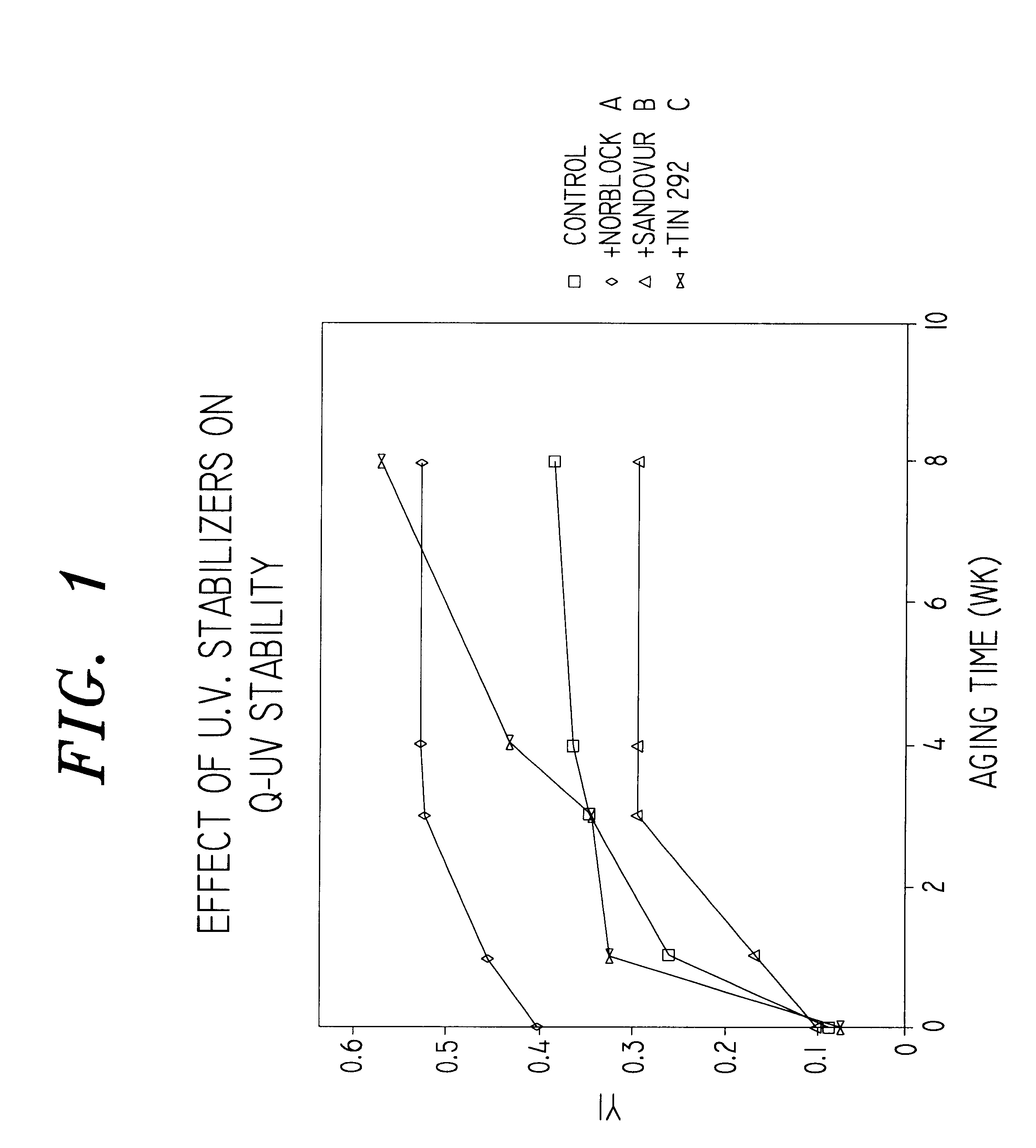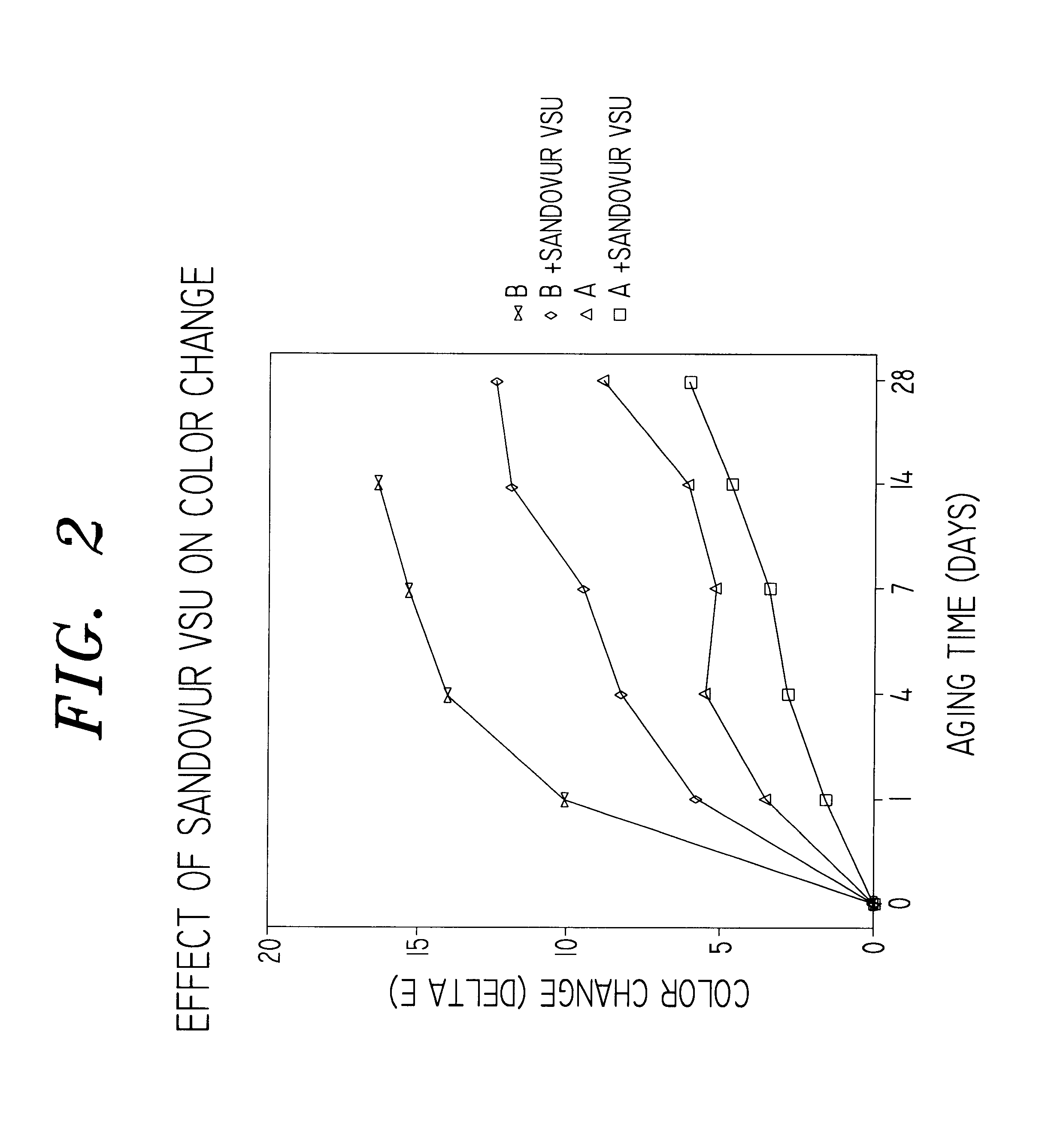Radiation-curable optical fiber coatings having reduced yellowing and fast cure speed
a technology of optical fiber and cure speed, applied in the field of radiation cureable optical fiber coatings having reduced yellowing and fast cure speed, can solve the problems of inability to cure, inability to cure, and inability to cure, etc., and achieves the effects of reducing the number of cure times
- Summary
- Abstract
- Description
- Claims
- Application Information
AI Technical Summary
Benefits of technology
Problems solved by technology
Method used
Image
Examples
example 2
Formulation of Inner Primary Coatings
A control inner primary coating composition without UV absorber was formulated from the pre-mixture ingredients summarized in Table II:
The control formulation of Table II, which did not comprise UV-absorber, was further formulated into several additional compositions by the addition of additive so that the newly formulated compositions' concentration of additive was 0.5 wt. % (and 99.5 wt. % of composition in Table II).
The additive for composition A was Norblock 7966 [2-(2'-hydroxy-5-methacryloxyethylphenyl)-2H-benzotriazole]; for composition B was Sanduvor VSU (2-ethyl,2'-ethoxy-oxalamide), and for composition C was Tinuvin 292 (which is a hindered amine light stabilizer).
The three formulations, A-C, which each contained one additive, and the control formulation of Table II were converted to 3 mil films and cured by UV light (1.0 J / cm.sup.2 under N.sub.2 at 8 cfm with Fusion D lamp). The yellowness index was measured as a function of aging time ...
example 3
Formulation of Inner Primary Coatings
Inner primary coatings were formulated according to Table III:
To 99.5% by wt. of each of the above compositions was added 0.5% by wt. SANDOVUR VSU. Film samples were prepared by coating and curing 10 mil films at 1.0 J / cm.sup.2, under a D-lamp (Fusion) in the presence of N.sub.2 and color change was measured at 0, 1, 4, 7, 14 and 28 days. Yellowness Index (YI) was calculated as described below, and delta E values estimated from the yellowness index. The results are provided in FIG. 2. Cured coating compositions containing 0.5% by wt SANDOVUR VSU consistently gave lower yellowness index and delta E values over a period of 28 days than the same compositions containing no UV absorbing compound.
In addition, the effect of the UV-absorber, Sandovur VSU (0.5 wt. %), on the cure speed (measured by FT-IR measurements) of composition 3B is illustrated in FIG. 3. The data show that cure speed, although made slower, is not substantially impaired, and fast cu...
example iv
Cure of Inner Primary Coating Together with Outer Primary Coating Having UV Stabilizer Therein
Two outer primary coating compositions were formulated from the following pre-mixture ingredients summarized in Table IV:
The formulation 4B included less UV absorber and did not comprise a fast cure phosphine oxide photoinitiator.
In addition, four inner primary coating compositions 4C-F were formulated from pre-mixture ingredients which are summarized below in Tables V and VI:
TABLE VI
Tests were carried out to test the curing of the four inner primary coatings (Tables V and VI) under the outer primary coatings (Table IV). These tests simulated a wet-on-wet optical fiber coating and cure process. Four samples comprising films of both inner and outer primary coatings were tested for yellowing and cure speed behavior:
Based on visual observation of the stickiness of the coatings, inner primary coating composition in sample 3 cured more quickly than the inner primary composition in sample 2. This...
PUM
| Property | Measurement | Unit |
|---|---|---|
| Fraction | aaaaa | aaaaa |
| Force | aaaaa | aaaaa |
| Fraction | aaaaa | aaaaa |
Abstract
Description
Claims
Application Information
 Login to View More
Login to View More - R&D
- Intellectual Property
- Life Sciences
- Materials
- Tech Scout
- Unparalleled Data Quality
- Higher Quality Content
- 60% Fewer Hallucinations
Browse by: Latest US Patents, China's latest patents, Technical Efficacy Thesaurus, Application Domain, Technology Topic, Popular Technical Reports.
© 2025 PatSnap. All rights reserved.Legal|Privacy policy|Modern Slavery Act Transparency Statement|Sitemap|About US| Contact US: help@patsnap.com



